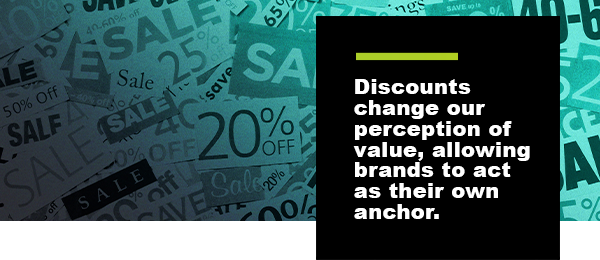The act of spending money can be exhilarating… or really painful. Anytime we are in the role of the consumer, our attitude towards a particular purchase shapes how we approach it — and how far into our pockets we’re willing to reach.
As marketers, we can use what we know about the psychology of spending to help potential buyers focus on the value that our goods and services can add to their lives. Here are just a few ways that studied psychological phenomena guide consumers through the decision-making process at retail.
1. Make the Price Reference Effect your friend.
When confronted with a huge variety of options, Goldilocks thinking usually takes over and we tend to favor items near the middle of the price continuum. The Price Reference Effect explains how shoppers use the heuristic of anchoring to determine whether or not an item’s price seems reasonable.
Of course, we have a better sense of what we can expect to pay for items that we buy weekly than we do for goods that we purchase infrequently (or those we’re purchasing for the very first time). An item’s anchor point, or perceived “average” price, might be determined through personal experience, category research, or even marketing materials and promotional offers.
As marketers, we are always looking for ways to encourage shoppers to move up the price continuum, but in order to convince them to upgrade to a more premium product, you must first understand their frame of reference and relationship to your product category.
To do this, you’ll need to examine your prime prospect. Do they shop your category often or only when they have a specific need? Are these consumers value-conscious above all else? Is the purchase of your product emotionally motivated in some way?
A pro contractor purchasing sealant for a job site will have an entirely different approach than a homeowner making a one-time purchase for a DIY project — determining how it’s different is the task of consumer research. The better you understand how to add value for your target consumers, the more effectively you can entice them to upgrade their purchase.
2. Be smart about discounts.
Anchoring also plays an important role when it comes to promotions and discounts. When you offer shoppers a deal, they will automatically compare the new price to the pre-discounted one, effectively allowing you to act as your own anchor.
Especially when you are searching for a foothold in a competitive or saturated space, discounts can get your product that all-important novel consideration. Temporarily offer your premium-branded oat milk at the same price as the house brand, and shoppers are likely to perceive it as a free upgrade.
Discounted items tend to retain their list price value in shoppers’ minds, which explains why getting a good deal at retail can sometimes give us the sensation that we’ve made money by making a purchase. If convincing consumers to take a chance on your brand is a challenge, this strategy can really accelerate growth

3. Understand the relationship between price and value.
Though we might not like to admit it, there’s solid evidence that consumers associate quality with price. We love a deal, but are often skeptical of the least-expensive items in the price continuum.
Oddly enough, this is particularly true when we’re less familiar with a product category. When it comes to big ticket, infrequent purchases, like lawn equipment or mattresses, most shoppers disregard the cheapest options because they aren’t sure which, if any, features are worth sacrificing to save money. Researchers can actually model this phenomenon using tools like the Van Westendorp Pricing Model.
While consumers do tend to believe that spendier items will perform better, last longer, and offer more satisfaction in ownership, there are limits — and those limits are determined by your prime prospect’s attitude towards your product and category.
It’s important to understand consumers’ emotional relationship to your brand. Even brands that aren’t considered “luxury” in the traditional sense may find that their prime prospect takes pride in owning their products. Consider the intangibles that convey with your goods: are you offering buyers a sense of positive self-regard or peace of mind?
Give your prime prospect more of what they value from your product category, and you’ll win their consideration while justifying spend on a more premium item.
Like what you're reading?


